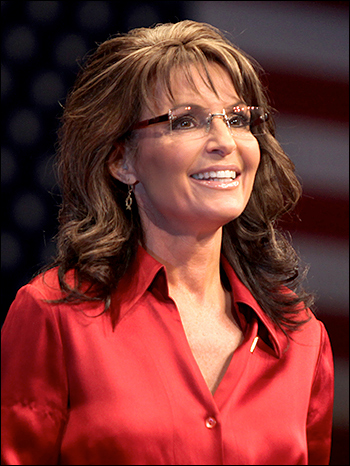
Sarah Palin, former Alaska governor and vice presidential candidate, is now running for the open at-large US House seat in The Last Frontier state.
April 5, 2022 — Former Republican vice presidential nominee and ex-Alaska governor, Sarah Palin, filed at Friday’s candidate declaration deadline to enter the special election being held June 11 to replace the late at-large congressman, Rep. Don Young (R-AK).
Along with Palin, 17 others also filed. The state officials will release the qualified list at some point this week. Of the preliminary group, nine are Republican, eight are Independent or from minor parties, and just one, local Anchorage Assemblyman Chris Constant, is a Democrat.
The June 11 special primary will be interesting since it is the first test of Alaska’s new electoral system that places everyone together on a jungle ballot and sends the top four, regardless of party preference, to the special general election. The special primary will be conducted through the mail.
The special general will be run concurrently with the Alaska regular primary election on Aug. 16. Therefore, those casting ballots will both choose a special election winner and nominees for the regular election at the same time, but in two separate votes.
Should no one from the top four reach the 50 percent threshold in the special general election, then the Ranked Choice Voting (RCV) system is utilized to choose a winner. The voters rank their choices one to four. Without anyone getting majority support, the last-place finisher is eliminated, and those ballots ranking that candidate first are located, and their second choices are added to the candidate totals. This process continues in rounds until one of the candidates obtains majority support. At that point, said candidate is awarded the seat and will serve the balance of the current term.
The filing deadline for the regular primary is June 1, and those running in the special, including Palin, may or may not file for the regular term. At this point, all are expected to do so.
In addition to Palin, some of the key candidates include Dr. Al Gross, who was the Democratic nominee for Senate in 2020 and raised and spent almost $20 million in his unsuccessful challenge of Sen. Dan Sullivan (R). In this special election, Dr. Gross is running as an Independent.
Others are state Sen. Josh Revak (R-Anchorage), former state Senate Majority Leader John Coghill (R), and software engineer Nick Begich III, the grandson of former US Rep. Nick Begich (D) who was killed in the plane crash in 1972 that opened the door for Rep. Young to win his initial election in a 1973 special. The younger Begich is running as a Republican. His uncle is Democratic former US senator and ex-Anchorage mayor, Mark Begich.
Though the field is large, it appears relatively weak, hence, the probable reason Palin entered as the deadline was expiring. She also likely believes the new top four jungle system would favor her. With universal name identification in the state, and a remaining political base, her chances of making the top four cut look strong. The special general election campaign period, from June 11 to Aug. 16, would then create a different campaign since the four finalists would become known entities and victory coalitions for each could then be constructed.
The RCV procedure, however, may not be as kind to Palin. Because she is controversial and created negatives for herself in the state, perhaps influenced when she resigned her position as governor after losing the national election on the presidential ticket with the late Sen. John McCain (R-AZ) in order to pursue money making media opportunities, she might not get as many 2s and 3s on the ranked ballots since her wider support base may not be large enough to move further than 1st choice.
On the other hand, this system could help Dr. Gross, who would also be a prime contender to qualify for the “Final Four.” Because of his name ID from the Senate race, and association with the Democrats, him getting large numbers of 2s and 3s from the ranking system is plausible.
Though Dr. Gross will appear as an Independent on the ballot, he would undoubtedly caucus with the Democrats should he win the special election. Therefore, he may be the party’s best opportunity candidate with whom to snatch this typically Republican at-large seat in the upcoming special election campaign.
The regular election, the primary of which is concurrent with the special general, could theoretically yield a different four-person finalist field. This could be another unique effect of Alaska’s untried electoral system.
With both Sarah Palin and Al Gross in this field of candidates, the June 11 Alaska at-large special congressional primary election is one in which we can expect a great deal of national media coverage. With a new and unique system in place for the first time, the end result could also lead to an unexpected conclusion.
